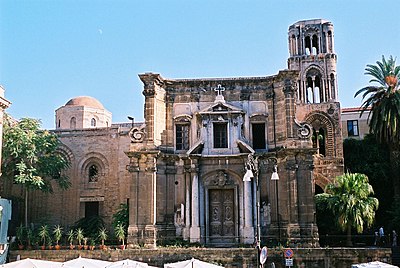PALERMO
The City is situated on the
margins of the Conca d’Oro, on the Tirreno Sea, in the
ample Golf of Palermo. It is dominated by Mount Pellegrino
(on which the Sanctuary of Santa Rosalia is situated, an annual
Meta of a huge, popular pilgrimage on 3-4 September).
L’asse viario (the Viario Axis) of historical
Palermo is constituted from Cassaro (from Arabic
qasr, meaning castle), today’s Corso V. Emanuele (already
Via Toledo), which runs from Porta Felice up to Porta Nuova,
on the hill, meeting perpendicularly in the small square called
“i Quattro Canti” (Piazza Vigliena), to the a
large arterial City road: via Mequeda, that from porta Sant’Antonino
arrives at porta Maqueda. The crossroads between the two main
arterial roads marks the nucleus of the old City, around which,
over the years, the Arabian-Norman and Spanish Palermo was
developed. Under the Bourbons, the City was amplified outside
the old City walls, in the direction of Monreale, beyond Cassaro.
Palermo is the native land of poets and authors (Giovanni
Meli, Giuseppe Tomasi of Lampedusa), of architects (G. Amato,
the Basile’s), sculpturers and plasterers (the Gagini’s,
Procopio and G. Serpotta), of musicians (A. Scarlatti, E.
Petrella), of patriots, scientists and politicians, as well
as philosophers and historians.
Regardless of its Greek name Pànormos, it was originally
a Phoenician settlement and then a Carthaginian one, and thanks
to an excellent port, it became the most powerful fortress
in Sicily. Apart from the temporary conquest by Pirro (276
BC), it remained in the hands of the Carthaginians until 254-253BC,
when it was conquered by the Romans. It therefore took on
the status of civitas libera et immunis (an independent and
duty-free state) and was established as a colony by Augusto
around 20BC, remaining the same with Vespasiano and Adriano.
Christianity reached Africa, probably at the dawning of its
civilization: definite confirmation of the first Bishop dates
back to the 5th Century.
From the 5th Century, there was a succession of conquests
and surrenders: the Vandali of Genserico, Odoacre (476), the
Ostrogoth’s (493), Belisario (535); retaken by Totila
(549), then due to the decisive victories of Narsete, it returned
shortly after (552) to the Byzantines, who reintroduced their
institutions and, in the complex, favoured its re-birth. In
831, after a siege of some months, it was occupied by the
Arabs, who installed a domination destined to last almost
two and a half centuries.
The Muslims left indelible signs of their own civilization
in the political-social structure, in fashion and in the City’s
look. Around the mid 10th Century, it was the capital of the
independent emirate of Banu Kalb, therefore becoming a metropolis
of 200,000 inhabitants where industry and commerce, mosques,
Palaces and gardens flourished. In this period, the centre
of Christian religion, and the Episcopate, transferred to
Monreale.
|
